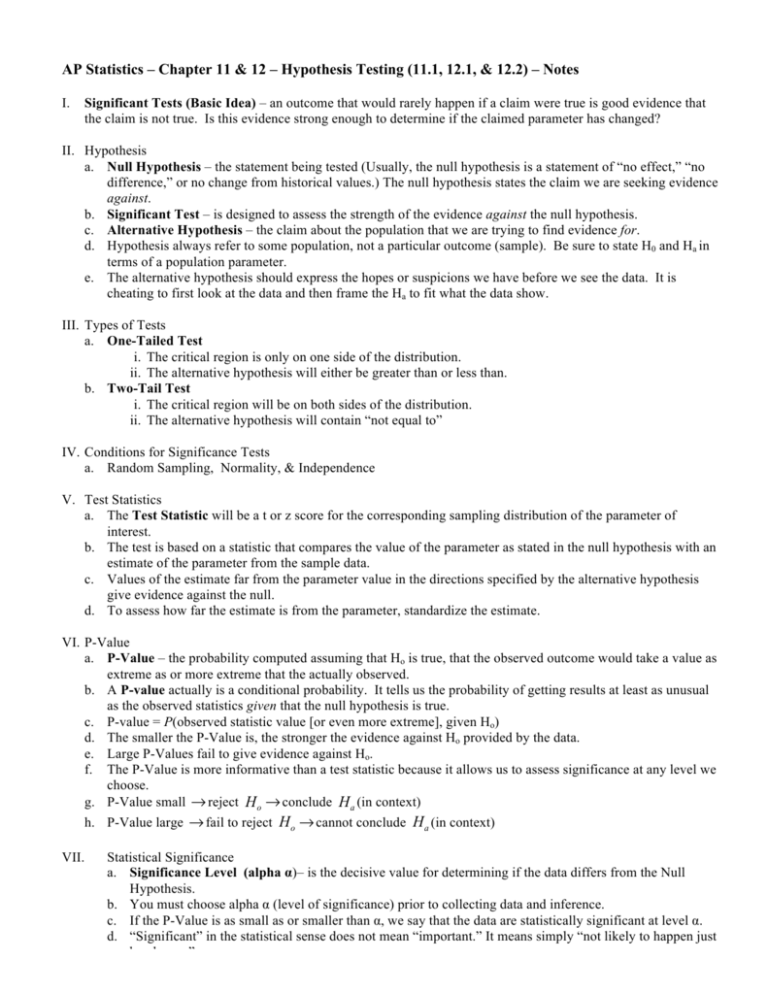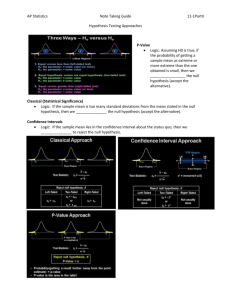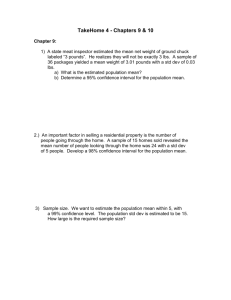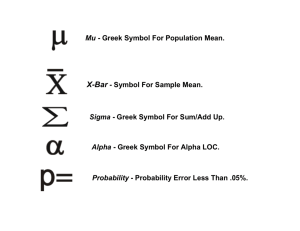AP Statistics – Chapter 11 & 12 – Hypothesis Testing (11.1, 12.1
advertisement

Name:& Date:& Block:& AP Statistics – Chapter 11 & 12 – Hypothesis Testing (11.1, 12.1, & 12.2) – Notes I. Significant Tests (Basic Idea) – an outcome that would rarely happen if a claim were true is good evidence that the claim is not true. Is this evidence strong enough to determine if the claimed parameter has changed? II. Hypothesis a. Null Hypothesis – the statement being tested (Usually, the null hypothesis is a statement of “no effect,” “no difference,” or no change from historical values.) The null hypothesis states the claim we are seeking evidence against. b. Significant Test – is designed to assess the strength of the evidence against the null hypothesis. c. Alternative Hypothesis – the claim about the population that we are trying to find evidence for. d. Hypothesis always refer to some population, not a particular outcome (sample). Be sure to state H0 and Ha in terms of a population parameter. e. The alternative hypothesis should express the hopes or suspicions we have before we see the data. It is cheating to first look at the data and then frame the Ha to fit what the data show. III. Types of Tests a. One-Tailed Test i. The critical region is only on one side of the distribution. ii. The alternative hypothesis will either be greater than or less than. b. Two-Tail Test i. The critical region will be on both sides of the distribution. ii. The alternative hypothesis will contain “not equal to” IV. Conditions for Significance Tests a. Random Sampling, Normality, & Independence V. Test Statistics a. The Test Statistic will be a t or z score for the corresponding sampling distribution of the parameter of interest. b. The test is based on a statistic that compares the value of the parameter as stated in the null hypothesis with an estimate of the parameter from the sample data. c. Values of the estimate far from the parameter value in the directions specified by the alternative hypothesis give evidence against the null. d. To assess how far the estimate is from the parameter, standardize the estimate. VI. P-Value a. P-Value – the probability computed assuming that Ho is true, that the observed outcome would take a value as extreme as or more extreme that the actually observed. b. A P-value actually is a conditional probability. It tells us the probability of getting results at least as unusual as the observed statistics given that the null hypothesis is true. c. P-value = P(observed statistic value [or even more extreme], given Ho) d. The smaller the P-Value is, the stronger the evidence against Ho provided by the data. e. Large P-Values fail to give evidence against Ho. f. The P-Value is more informative than a test statistic because it allows us to assess significance at any level we choose. g. P-Value small → reject H o → conclude H a (in context) h. P-Value large → fail to reject H o → cannot conclude H a (in context) VII. Statistical Significance a. Significance Level (alpha α)– is the decisive value for determining if the data differs from the Null Hypothesis. b. You must choose alpha α (level of significance) prior to collecting data and inference. c. If the P-Value is as small as or smaller than α, we say that the data are statistically significant at level α. d. “Significant” in the statistical sense does not mean “important.” It means simply “not likely to happen just by chance.” Name:& Date:& Block:& e. P-Value < α → reject H o → conclude H a (in context) f. P-Value ≥ α → fail to reject H o → cannot conclude H a (in context) VIII. Conclusion a. Your conclusion should state a result with a connection to your calculations and should be stated in the context of the problem. b. You will either reject Ho or fail to reject Ho based on whether our result is statistically significant. c. You do not “accept” the null hypothesis because you do not have evidence to prove that it is true, you just lack evidence to prove that it is false. d. You will reject if your test statistics falls into your critical region, or if your P-Value is smaller than alpha α. e. You reject Ho if our result is too unlikely to have occurred by chance assuming Ho it true. f. Warning: if you are going to draw a conclusion based on statistical significance, then the significance level α should be stated before the data are produced. g. Failing to find evidence against Ho only means that the data are consistent with Ho, not that we have clear evidence that Ho is true. IX. Confidence Intervals & Two-Sided Tests a. Duality – a link between two-sided significance tests and confidence intervals. b. A level α two-sided significance test rejects a hypothesis Ho: µ = µo exactly when the value µo falls outside a level 1 – α confidence interval for µ. X. Z Test for a Population Mean a. To test the hypotheses Ho: µ = µo based on an SRS of size n from a population with unknown mean µ and known standard deviation σ, compute the one-sample z statistic z = x − µ0 σx . These P-Values are exact if n the population distribution is Normal and are approximately correct for large n in other cases. b. In terms of a variable Z having the standard Normal distribution, the P-value for a test of Ho against Ha: µ > µo is P(Z ≥ z) Ha: µ < µo is P(Z ≤ z) Ha: µ ≠ µo is P(Z ≥ z ) XI. t Test for a Population Mean a. Draw an SRS of size n from a population that has the Normal distribution with mean µ and standard deviation σ. The one sample t statistic t = x−µ has the t distribution with n − 1 degrees of freedom. s n These P-values are exact if the population distribution is Normal and are approximately correct for large n in other cases. b. In terms of a random variable T having the t n−1 distribution, the P-value for a test of H o against Ha : µ > µ o is P(T ≥ t ) Ha : µ ≠ µ o is 2P(T ≥ t ) Ha : µ < µ o is P(T ≤ t ) Name:& Date:& Block:& XII. Matched Paired Designs a. You can not treat a matched pairs design as two separate samples, because the measurements are collected from the same individual (two different types of measurements from the same person). Therefore, the samples are dependent (due to confounding variables) and not independent. b. Subtract the corresponding measurements (measurement 1 from person a minus measurement 2 from person a) and then test to see if the mean difference is significant. c. Once you have found the differences, treat them as a single sample. Then test the mean. XIII. z Test for a Population Proportion a. Choose a SRS of size n from a large population with unknown proportion p of successes. To test the hypothesis H o : p = p , compute the z statistic z = p − p . pq n b. In terms of a random variable Z having the standard Normal Distribution, the approximate P-value for a test of H o against Ha: p > p is P(Z ≥ z) Ha: p < p &is P(Z ≤ z) Ha: p ≠ p is P(Z ≥ z ) c. Normality Condition: Use this test when the expected number of successes np and failures nq are both at least 10. XIV. Process for Carrying Out Significance Tests a. Problem i. Population & Parameter of Interest ii. Null & Alternative Hypothesis b. Conditions i. SRS ii. Normality iii. Independence c. Calculations – if the conditions are met, carry out the inference procedure. i. Critical value (corresponding to α) & critical region ii. Test statistic (z score or t score) iii. P-Value (one sided or two sided) d. Conclusion i. State your Conclusion: Determine whether to reject or fail to reject the null hypothesis ii. Connection: Write a sentence, in the context of the problem, showing evidence for your conclusion (test statistic and P-Value). iii. Interpret what the P-Value means in the context of the problem.









